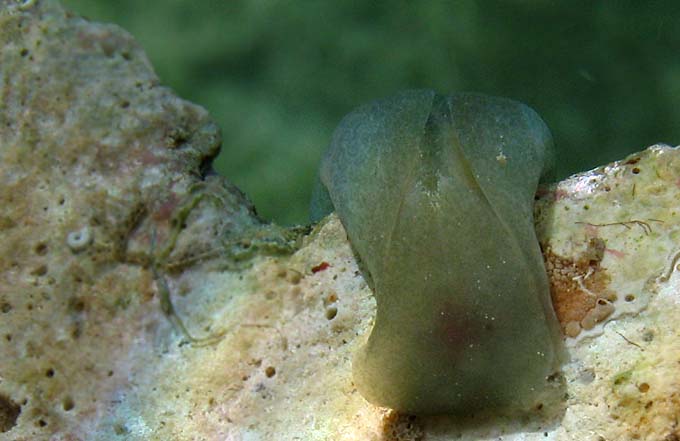(Rüppell & Leuckart, 1830)
This species has been observed on Reunion, Mauritius, Mayotte and Madagascar Islands
The head shield, proportionally very small, was triangular, smooth and trilobared or bilobated anteriorly. Remarkable resemblance to an aglajid. Small specimens are pink and larger ones ranging from a translucent pale green or yellow to a dark greenish-black
|

|
|
| Showing species characteristics... | Photo Philibert Bidgrain |
|
See more about : Sightening and mating periods
See more about : Phanerophthalmus smaragdinusvariability in Southwest Indian ocean
See more about spawning behavior : Phanerophthalmus smaragdinus
Remarks :
Identification confirmed by Bill Rudman and Nathalie Yonow
Many spécimens in Reunion Island have a white marks on the head shield There was white pigment in a dense longitudinal band on the posterior of the head shield extending onto Hancok's organ
This species in communly called P. smaragdinus, but this name is not validated under the terms of article 23.9.1 of the new code of zoological nomenclature. (see N. Yonow, 2000, publication). We should call it P. olivaceus (Ehrenberg, 1828)
Synonymous : (according Worms)
- Bulla smaragdina Rüppell & Leuckart, 1830 - Phanerophthalmus olivaceus (Ehrenberg, 1828)
- Cryptophthalmus olivaceus Ehrenberg, 1828
Bibliographic data :
There was white pigment in a dense longitudinal band on the posterior of the head shield extending onto Hancok's organ
Despite looking like an aglajid from the outside, a quick look at the gut shows that this animal is a herbivore closely related to Haminoea, with a similar radula and gizzard, with three grinding chitinous plates.
It appears to lack an external shell, but if the parapodia are opened, a small opaque white shell plate is visible on the posterior end of the animal.
The round opening that can be seen at the posterior end is in fact the "exhalant siphon" from the mantle cavity.
According Bill Rudman, Phanerophthalmus gets some of its body colour from the algae it is feeding on, which could explain some of the colour variation from pink, yellow to dark green.
In sacoglossans the colour is often affected by the colour of the chloroplasts they acquire from their food, but in haminoeids the food is crushed and digested and chloroplasts are not retained, so they would need to have a mechanism to retain colour pigments from their food.
References :
Bill Rudman Seaslug site : Sea Slug Forum : Phanerophthalmus smaragdinus
Nudipixel Phanerophthalmus smaragdinus
Publications :
Rudman,W.B., 1972. The herbivorous opisthobranch genera Phanerophthalmus A.Adams and Smaragdinella A.Adams. Journal of Natural History, 5 : 647-675.
Yonow,N., 2000. Red Sea Opistobranchia 4 : The orders Cephalaspidea, Anaspidea, Notaspidea and Nudibranhia : Dendronotacea and Aelidacea. Fauna of Arabia 18: 87-131
Other photos of Phanerophthalmus smaragdinus :
 |
Philibert Bidgrain Réunion, La Saline lagoon, less 1 m, 25 February 2010, size : 30 mm Very large specimens found under a rock with spawn... This spawn looks like Cephalaspidea spawn... May be their spawn??? A green color form. The round opening (a) that can be seen at the posterior end is in fact the "exhalant siphon" from the mantle cavity.  |
Philibert Bidgrain Réunion, La Saline lagoon, less 1 m, 25 February 2010, size : 30 mm A very large specimen found under a rock with spawn... The head shield, proportionally very small, was triangular, smooth and trilobared or bilobated anteriorly. |
 |
 |
Maurice Jay Réunion, "Boucan" at Saint Gilles, size 40 mm Found crawling on algae Animal with a white mark on the head shield A dark green color form |
Hugues Flodrops Réunion, Etang salé les bains on the rocky coast, less 1 m, 25 September 2007, size : 20 -25 mm. Animal with a white mark on the head shield A pink color form |
 |
 |
Hugues Flodrops Réunion, Etang salé les bains on the rocky coast, less 1 m, 25 September 2007, size : 20 -25 mm. Animal with a white mark on the head shield A green color form |
Eva Fontaine mtsanga mboueanatsa, Mayotte, reef flat zone, less 1 m, 21 October 2008, size : 15 mm A green color form. |
 |
 |
Christophe Cadet Réunion, Etang salé, on the rocky coast, less 1 m, 12 February 2010, size : 20 mm Animal with a white mark on the head shield A intense pink color form |
Philibert Bidgrain Réunion, La saline, less 1 m, 26 November 2010, during the night, size : 35 mm
A very large specimen
|
 |
More photos from Indian Ocean
See more about : Phanerophthalmus smaragdinus variability in Southwest Indian ocean
See more about spawning behavior : Phanerophthalmus smaragdinus
Reunion, Phanerophthalmus smaragdinus like an ostrich, at La Saline, by Philibert Bidgrain
Madagascar, Phanerophthalmus smaragdinus trailing, at Nosy bé, by Philibert Bidgrain